Social Determinants of Health in Australia
VerifiedAdded on 2023/06/13
|16
|4312
|311
AI Summary
This paper critically analyses four articles that are focused on the living and housing conditions among the Australian indigenous communities and how social factors discussed influence the health of indigenous communities. The articles highlight the impact of poor living conditions, lack of access to clean water and sanitation, and overcrowding on the health of indigenous populations in Australia. The paper also discusses the need for community-controlled housing and the role of politics in addressing housing issues.
Contribute Materials
Your contribution can guide someone’s learning journey. Share your
documents today.
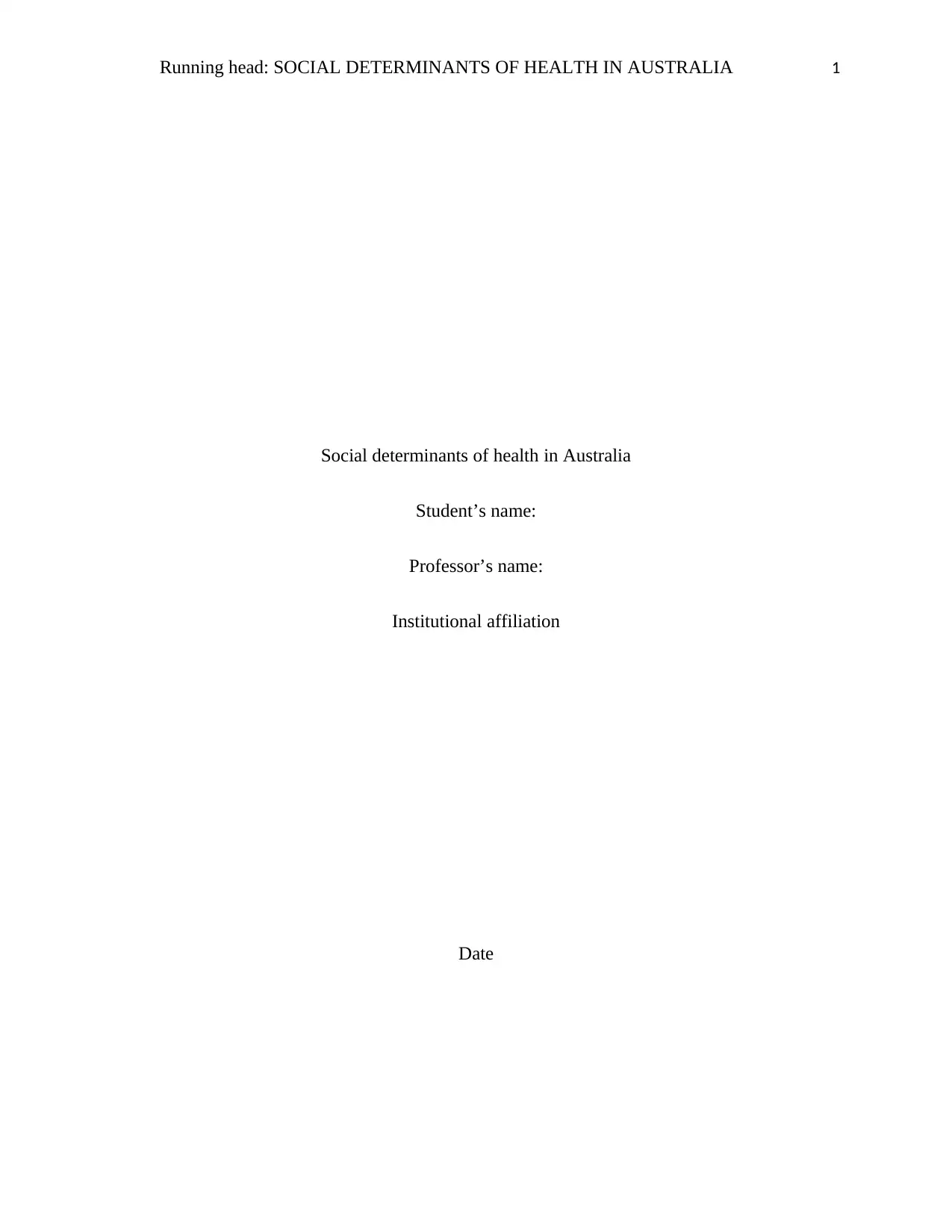
Running head: SOCIAL DETERMINANTS OF HEALTH IN AUSTRALIA 1
Social determinants of health in Australia
Student’s name:
Professor’s name:
Institutional affiliation
Date
Social determinants of health in Australia
Student’s name:
Professor’s name:
Institutional affiliation
Date
Secure Best Marks with AI Grader
Need help grading? Try our AI Grader for instant feedback on your assignments.
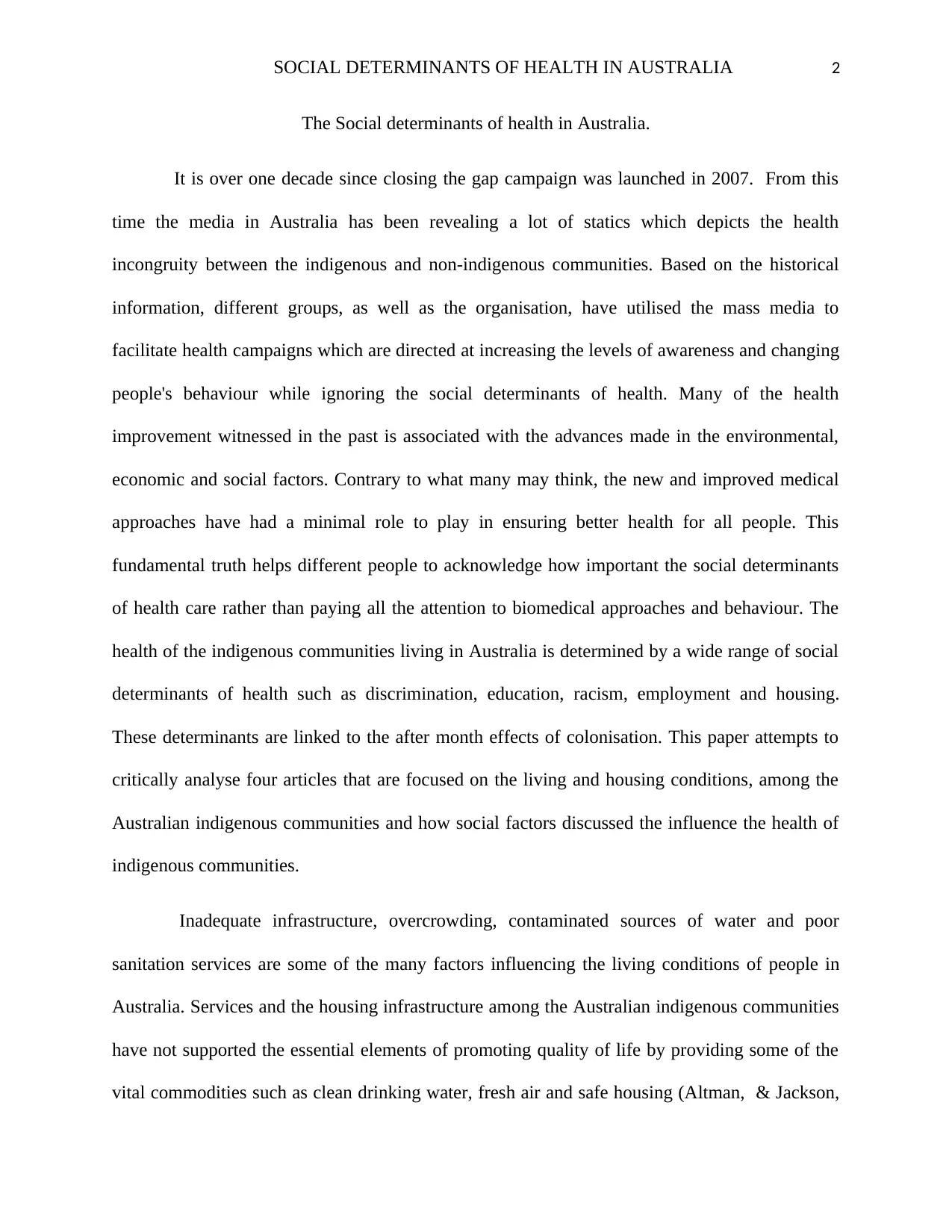
SOCIAL DETERMINANTS OF HEALTH IN AUSTRALIA 2
The Social determinants of health in Australia.
It is over one decade since closing the gap campaign was launched in 2007. From this
time the media in Australia has been revealing a lot of statics which depicts the health
incongruity between the indigenous and non-indigenous communities. Based on the historical
information, different groups, as well as the organisation, have utilised the mass media to
facilitate health campaigns which are directed at increasing the levels of awareness and changing
people's behaviour while ignoring the social determinants of health. Many of the health
improvement witnessed in the past is associated with the advances made in the environmental,
economic and social factors. Contrary to what many may think, the new and improved medical
approaches have had a minimal role to play in ensuring better health for all people. This
fundamental truth helps different people to acknowledge how important the social determinants
of health care rather than paying all the attention to biomedical approaches and behaviour. The
health of the indigenous communities living in Australia is determined by a wide range of social
determinants of health such as discrimination, education, racism, employment and housing.
These determinants are linked to the after month effects of colonisation. This paper attempts to
critically analyse four articles that are focused on the living and housing conditions, among the
Australian indigenous communities and how social factors discussed the influence the health of
indigenous communities.
Inadequate infrastructure, overcrowding, contaminated sources of water and poor
sanitation services are some of the many factors influencing the living conditions of people in
Australia. Services and the housing infrastructure among the Australian indigenous communities
have not supported the essential elements of promoting quality of life by providing some of the
vital commodities such as clean drinking water, fresh air and safe housing (Altman, & Jackson,
The Social determinants of health in Australia.
It is over one decade since closing the gap campaign was launched in 2007. From this
time the media in Australia has been revealing a lot of statics which depicts the health
incongruity between the indigenous and non-indigenous communities. Based on the historical
information, different groups, as well as the organisation, have utilised the mass media to
facilitate health campaigns which are directed at increasing the levels of awareness and changing
people's behaviour while ignoring the social determinants of health. Many of the health
improvement witnessed in the past is associated with the advances made in the environmental,
economic and social factors. Contrary to what many may think, the new and improved medical
approaches have had a minimal role to play in ensuring better health for all people. This
fundamental truth helps different people to acknowledge how important the social determinants
of health care rather than paying all the attention to biomedical approaches and behaviour. The
health of the indigenous communities living in Australia is determined by a wide range of social
determinants of health such as discrimination, education, racism, employment and housing.
These determinants are linked to the after month effects of colonisation. This paper attempts to
critically analyse four articles that are focused on the living and housing conditions, among the
Australian indigenous communities and how social factors discussed the influence the health of
indigenous communities.
Inadequate infrastructure, overcrowding, contaminated sources of water and poor
sanitation services are some of the many factors influencing the living conditions of people in
Australia. Services and the housing infrastructure among the Australian indigenous communities
have not supported the essential elements of promoting quality of life by providing some of the
vital commodities such as clean drinking water, fresh air and safe housing (Altman, & Jackson,
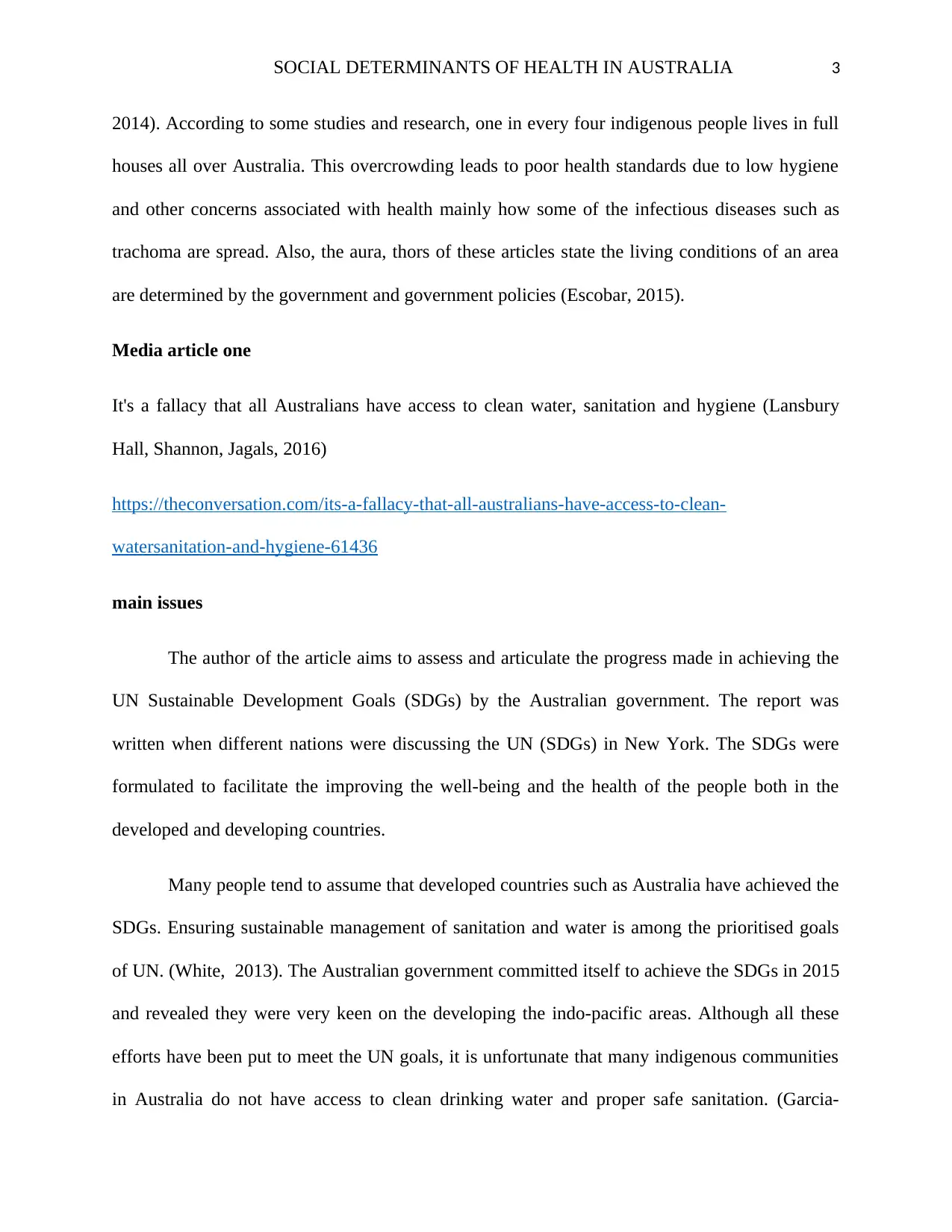
SOCIAL DETERMINANTS OF HEALTH IN AUSTRALIA 3
2014). According to some studies and research, one in every four indigenous people lives in full
houses all over Australia. This overcrowding leads to poor health standards due to low hygiene
and other concerns associated with health mainly how some of the infectious diseases such as
trachoma are spread. Also, the aura, thors of these articles state the living conditions of an area
are determined by the government and government policies (Escobar, 2015).
Media article one
It's a fallacy that all Australians have access to clean water, sanitation and hygiene (Lansbury
Hall, Shannon, Jagals, 2016)
https://theconversation.com/its-a-fallacy-that-all-australians-have-access-to-clean-
watersanitation-and-hygiene-61436
main issues
The author of the article aims to assess and articulate the progress made in achieving the
UN Sustainable Development Goals (SDGs) by the Australian government. The report was
written when different nations were discussing the UN (SDGs) in New York. The SDGs were
formulated to facilitate the improving the well-being and the health of the people both in the
developed and developing countries.
Many people tend to assume that developed countries such as Australia have achieved the
SDGs. Ensuring sustainable management of sanitation and water is among the prioritised goals
of UN. (White, 2013). The Australian government committed itself to achieve the SDGs in 2015
and revealed they were very keen on the developing the indo-pacific areas. Although all these
efforts have been put to meet the UN goals, it is unfortunate that many indigenous communities
in Australia do not have access to clean drinking water and proper safe sanitation. (Garcia-
2014). According to some studies and research, one in every four indigenous people lives in full
houses all over Australia. This overcrowding leads to poor health standards due to low hygiene
and other concerns associated with health mainly how some of the infectious diseases such as
trachoma are spread. Also, the aura, thors of these articles state the living conditions of an area
are determined by the government and government policies (Escobar, 2015).
Media article one
It's a fallacy that all Australians have access to clean water, sanitation and hygiene (Lansbury
Hall, Shannon, Jagals, 2016)
https://theconversation.com/its-a-fallacy-that-all-australians-have-access-to-clean-
watersanitation-and-hygiene-61436
main issues
The author of the article aims to assess and articulate the progress made in achieving the
UN Sustainable Development Goals (SDGs) by the Australian government. The report was
written when different nations were discussing the UN (SDGs) in New York. The SDGs were
formulated to facilitate the improving the well-being and the health of the people both in the
developed and developing countries.
Many people tend to assume that developed countries such as Australia have achieved the
SDGs. Ensuring sustainable management of sanitation and water is among the prioritised goals
of UN. (White, 2013). The Australian government committed itself to achieve the SDGs in 2015
and revealed they were very keen on the developing the indo-pacific areas. Although all these
efforts have been put to meet the UN goals, it is unfortunate that many indigenous communities
in Australia do not have access to clean drinking water and proper safe sanitation. (Garcia-
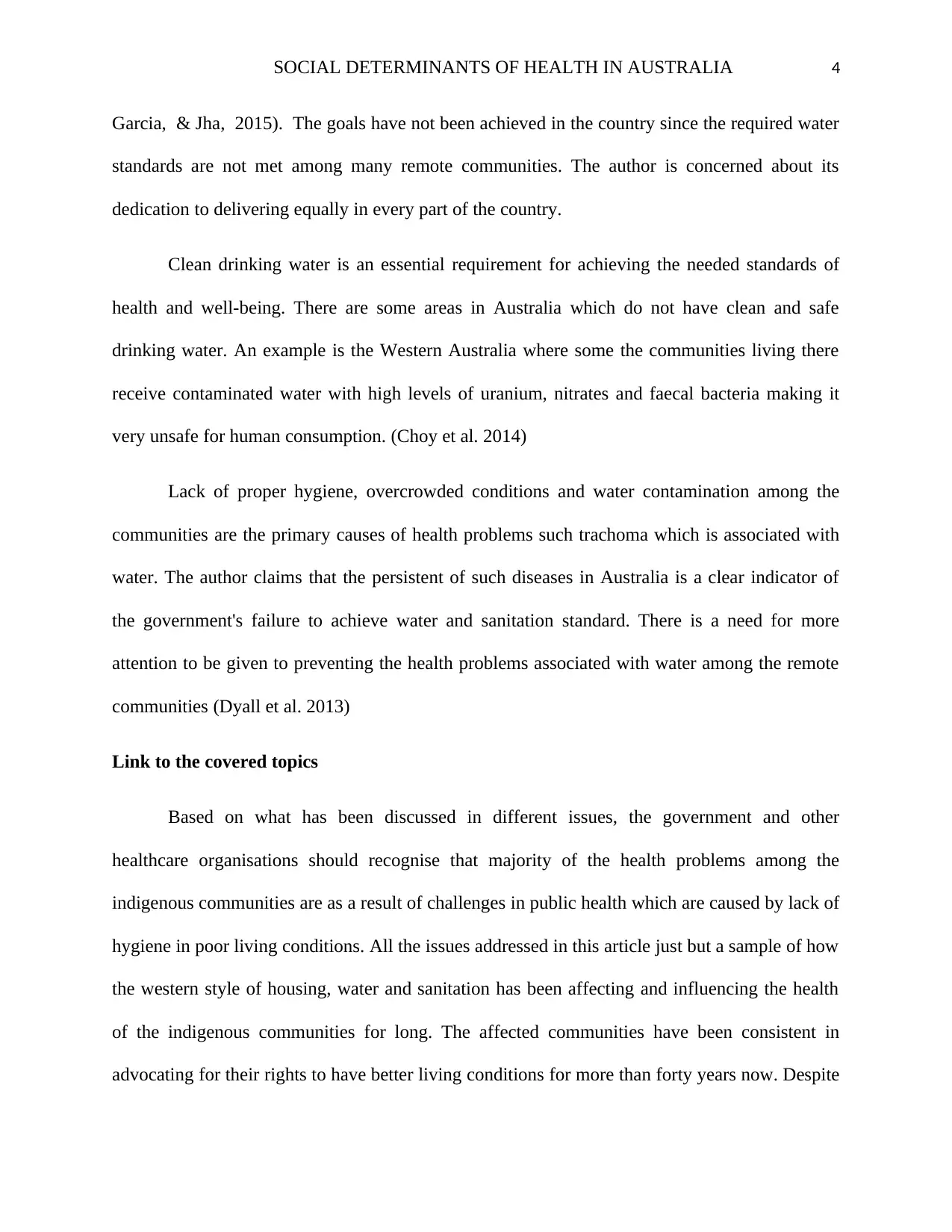
SOCIAL DETERMINANTS OF HEALTH IN AUSTRALIA 4
Garcia, & Jha, 2015). The goals have not been achieved in the country since the required water
standards are not met among many remote communities. The author is concerned about its
dedication to delivering equally in every part of the country.
Clean drinking water is an essential requirement for achieving the needed standards of
health and well-being. There are some areas in Australia which do not have clean and safe
drinking water. An example is the Western Australia where some the communities living there
receive contaminated water with high levels of uranium, nitrates and faecal bacteria making it
very unsafe for human consumption. (Choy et al. 2014)
Lack of proper hygiene, overcrowded conditions and water contamination among the
communities are the primary causes of health problems such trachoma which is associated with
water. The author claims that the persistent of such diseases in Australia is a clear indicator of
the government's failure to achieve water and sanitation standard. There is a need for more
attention to be given to preventing the health problems associated with water among the remote
communities (Dyall et al. 2013)
Link to the covered topics
Based on what has been discussed in different issues, the government and other
healthcare organisations should recognise that majority of the health problems among the
indigenous communities are as a result of challenges in public health which are caused by lack of
hygiene in poor living conditions. All the issues addressed in this article just but a sample of how
the western style of housing, water and sanitation has been affecting and influencing the health
of the indigenous communities for long. The affected communities have been consistent in
advocating for their rights to have better living conditions for more than forty years now. Despite
Garcia, & Jha, 2015). The goals have not been achieved in the country since the required water
standards are not met among many remote communities. The author is concerned about its
dedication to delivering equally in every part of the country.
Clean drinking water is an essential requirement for achieving the needed standards of
health and well-being. There are some areas in Australia which do not have clean and safe
drinking water. An example is the Western Australia where some the communities living there
receive contaminated water with high levels of uranium, nitrates and faecal bacteria making it
very unsafe for human consumption. (Choy et al. 2014)
Lack of proper hygiene, overcrowded conditions and water contamination among the
communities are the primary causes of health problems such trachoma which is associated with
water. The author claims that the persistent of such diseases in Australia is a clear indicator of
the government's failure to achieve water and sanitation standard. There is a need for more
attention to be given to preventing the health problems associated with water among the remote
communities (Dyall et al. 2013)
Link to the covered topics
Based on what has been discussed in different issues, the government and other
healthcare organisations should recognise that majority of the health problems among the
indigenous communities are as a result of challenges in public health which are caused by lack of
hygiene in poor living conditions. All the issues addressed in this article just but a sample of how
the western style of housing, water and sanitation has been affecting and influencing the health
of the indigenous communities for long. The affected communities have been consistent in
advocating for their rights to have better living conditions for more than forty years now. Despite
Secure Best Marks with AI Grader
Need help grading? Try our AI Grader for instant feedback on your assignments.
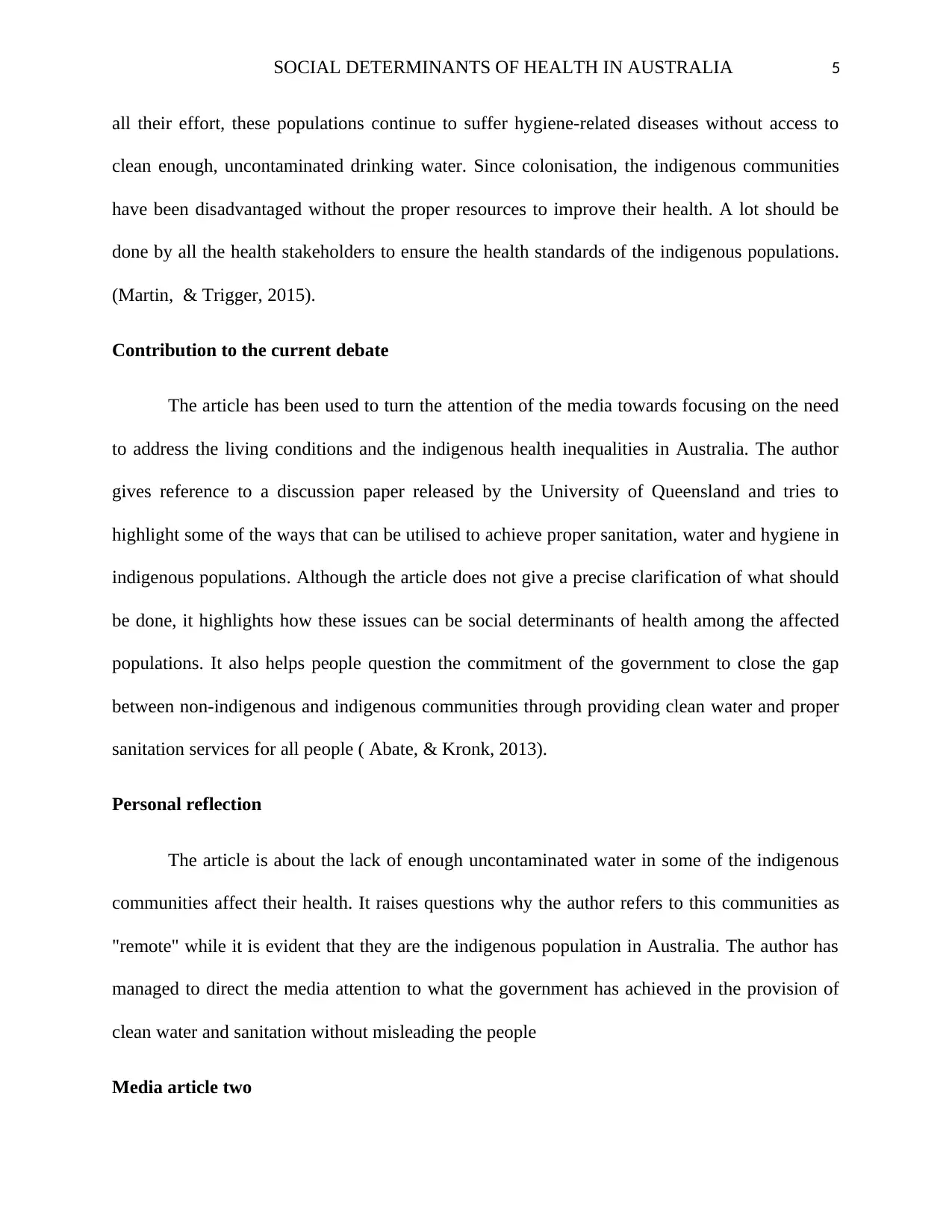
SOCIAL DETERMINANTS OF HEALTH IN AUSTRALIA 5
all their effort, these populations continue to suffer hygiene-related diseases without access to
clean enough, uncontaminated drinking water. Since colonisation, the indigenous communities
have been disadvantaged without the proper resources to improve their health. A lot should be
done by all the health stakeholders to ensure the health standards of the indigenous populations.
(Martin, & Trigger, 2015).
Contribution to the current debate
The article has been used to turn the attention of the media towards focusing on the need
to address the living conditions and the indigenous health inequalities in Australia. The author
gives reference to a discussion paper released by the University of Queensland and tries to
highlight some of the ways that can be utilised to achieve proper sanitation, water and hygiene in
indigenous populations. Although the article does not give a precise clarification of what should
be done, it highlights how these issues can be social determinants of health among the affected
populations. It also helps people question the commitment of the government to close the gap
between non-indigenous and indigenous communities through providing clean water and proper
sanitation services for all people ( Abate, & Kronk, 2013).
Personal reflection
The article is about the lack of enough uncontaminated water in some of the indigenous
communities affect their health. It raises questions why the author refers to this communities as
"remote" while it is evident that they are the indigenous population in Australia. The author has
managed to direct the media attention to what the government has achieved in the provision of
clean water and sanitation without misleading the people
Media article two
all their effort, these populations continue to suffer hygiene-related diseases without access to
clean enough, uncontaminated drinking water. Since colonisation, the indigenous communities
have been disadvantaged without the proper resources to improve their health. A lot should be
done by all the health stakeholders to ensure the health standards of the indigenous populations.
(Martin, & Trigger, 2015).
Contribution to the current debate
The article has been used to turn the attention of the media towards focusing on the need
to address the living conditions and the indigenous health inequalities in Australia. The author
gives reference to a discussion paper released by the University of Queensland and tries to
highlight some of the ways that can be utilised to achieve proper sanitation, water and hygiene in
indigenous populations. Although the article does not give a precise clarification of what should
be done, it highlights how these issues can be social determinants of health among the affected
populations. It also helps people question the commitment of the government to close the gap
between non-indigenous and indigenous communities through providing clean water and proper
sanitation services for all people ( Abate, & Kronk, 2013).
Personal reflection
The article is about the lack of enough uncontaminated water in some of the indigenous
communities affect their health. It raises questions why the author refers to this communities as
"remote" while it is evident that they are the indigenous population in Australia. The author has
managed to direct the media attention to what the government has achieved in the provision of
clean water and sanitation without misleading the people
Media article two
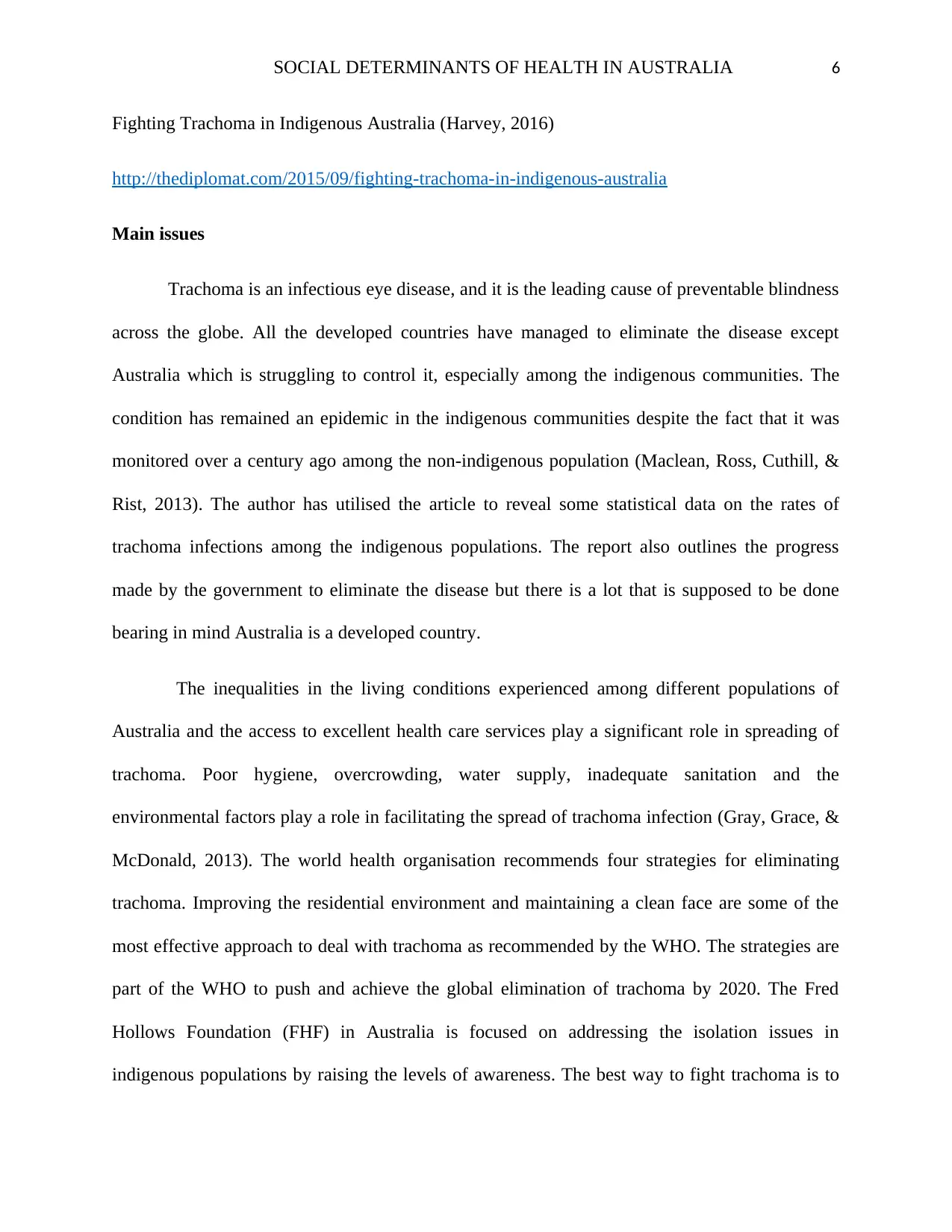
SOCIAL DETERMINANTS OF HEALTH IN AUSTRALIA 6
Fighting Trachoma in Indigenous Australia (Harvey, 2016)
http://thediplomat.com/2015/09/fighting-trachoma-in-indigenous-australia
Main issues
Trachoma is an infectious eye disease, and it is the leading cause of preventable blindness
across the globe. All the developed countries have managed to eliminate the disease except
Australia which is struggling to control it, especially among the indigenous communities. The
condition has remained an epidemic in the indigenous communities despite the fact that it was
monitored over a century ago among the non-indigenous population (Maclean, Ross, Cuthill, &
Rist, 2013). The author has utilised the article to reveal some statistical data on the rates of
trachoma infections among the indigenous populations. The report also outlines the progress
made by the government to eliminate the disease but there is a lot that is supposed to be done
bearing in mind Australia is a developed country.
The inequalities in the living conditions experienced among different populations of
Australia and the access to excellent health care services play a significant role in spreading of
trachoma. Poor hygiene, overcrowding, water supply, inadequate sanitation and the
environmental factors play a role in facilitating the spread of trachoma infection (Gray, Grace, &
McDonald, 2013). The world health organisation recommends four strategies for eliminating
trachoma. Improving the residential environment and maintaining a clean face are some of the
most effective approach to deal with trachoma as recommended by the WHO. The strategies are
part of the WHO to push and achieve the global elimination of trachoma by 2020. The Fred
Hollows Foundation (FHF) in Australia is focused on addressing the isolation issues in
indigenous populations by raising the levels of awareness. The best way to fight trachoma is to
Fighting Trachoma in Indigenous Australia (Harvey, 2016)
http://thediplomat.com/2015/09/fighting-trachoma-in-indigenous-australia
Main issues
Trachoma is an infectious eye disease, and it is the leading cause of preventable blindness
across the globe. All the developed countries have managed to eliminate the disease except
Australia which is struggling to control it, especially among the indigenous communities. The
condition has remained an epidemic in the indigenous communities despite the fact that it was
monitored over a century ago among the non-indigenous population (Maclean, Ross, Cuthill, &
Rist, 2013). The author has utilised the article to reveal some statistical data on the rates of
trachoma infections among the indigenous populations. The report also outlines the progress
made by the government to eliminate the disease but there is a lot that is supposed to be done
bearing in mind Australia is a developed country.
The inequalities in the living conditions experienced among different populations of
Australia and the access to excellent health care services play a significant role in spreading of
trachoma. Poor hygiene, overcrowding, water supply, inadequate sanitation and the
environmental factors play a role in facilitating the spread of trachoma infection (Gray, Grace, &
McDonald, 2013). The world health organisation recommends four strategies for eliminating
trachoma. Improving the residential environment and maintaining a clean face are some of the
most effective approach to deal with trachoma as recommended by the WHO. The strategies are
part of the WHO to push and achieve the global elimination of trachoma by 2020. The Fred
Hollows Foundation (FHF) in Australia is focused on addressing the isolation issues in
indigenous populations by raising the levels of awareness. The best way to fight trachoma is to
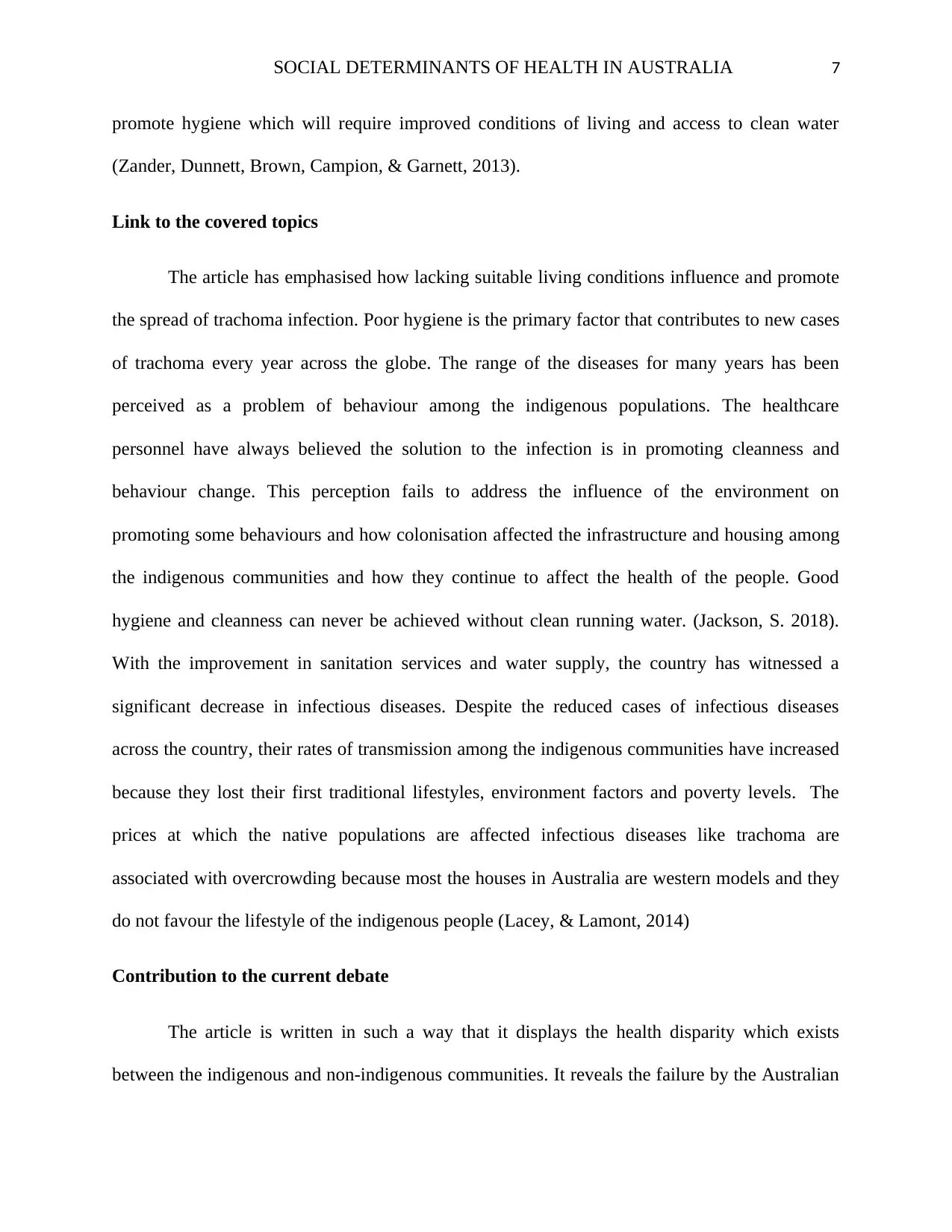
SOCIAL DETERMINANTS OF HEALTH IN AUSTRALIA 7
promote hygiene which will require improved conditions of living and access to clean water
(Zander, Dunnett, Brown, Campion, & Garnett, 2013).
Link to the covered topics
The article has emphasised how lacking suitable living conditions influence and promote
the spread of trachoma infection. Poor hygiene is the primary factor that contributes to new cases
of trachoma every year across the globe. The range of the diseases for many years has been
perceived as a problem of behaviour among the indigenous populations. The healthcare
personnel have always believed the solution to the infection is in promoting cleanness and
behaviour change. This perception fails to address the influence of the environment on
promoting some behaviours and how colonisation affected the infrastructure and housing among
the indigenous communities and how they continue to affect the health of the people. Good
hygiene and cleanness can never be achieved without clean running water. (Jackson, S. 2018).
With the improvement in sanitation services and water supply, the country has witnessed a
significant decrease in infectious diseases. Despite the reduced cases of infectious diseases
across the country, their rates of transmission among the indigenous communities have increased
because they lost their first traditional lifestyles, environment factors and poverty levels. The
prices at which the native populations are affected infectious diseases like trachoma are
associated with overcrowding because most the houses in Australia are western models and they
do not favour the lifestyle of the indigenous people (Lacey, & Lamont, 2014)
Contribution to the current debate
The article is written in such a way that it displays the health disparity which exists
between the indigenous and non-indigenous communities. It reveals the failure by the Australian
promote hygiene which will require improved conditions of living and access to clean water
(Zander, Dunnett, Brown, Campion, & Garnett, 2013).
Link to the covered topics
The article has emphasised how lacking suitable living conditions influence and promote
the spread of trachoma infection. Poor hygiene is the primary factor that contributes to new cases
of trachoma every year across the globe. The range of the diseases for many years has been
perceived as a problem of behaviour among the indigenous populations. The healthcare
personnel have always believed the solution to the infection is in promoting cleanness and
behaviour change. This perception fails to address the influence of the environment on
promoting some behaviours and how colonisation affected the infrastructure and housing among
the indigenous communities and how they continue to affect the health of the people. Good
hygiene and cleanness can never be achieved without clean running water. (Jackson, S. 2018).
With the improvement in sanitation services and water supply, the country has witnessed a
significant decrease in infectious diseases. Despite the reduced cases of infectious diseases
across the country, their rates of transmission among the indigenous communities have increased
because they lost their first traditional lifestyles, environment factors and poverty levels. The
prices at which the native populations are affected infectious diseases like trachoma are
associated with overcrowding because most the houses in Australia are western models and they
do not favour the lifestyle of the indigenous people (Lacey, & Lamont, 2014)
Contribution to the current debate
The article is written in such a way that it displays the health disparity which exists
between the indigenous and non-indigenous communities. It reveals the failure by the Australian
Paraphrase This Document
Need a fresh take? Get an instant paraphrase of this document with our AI Paraphraser
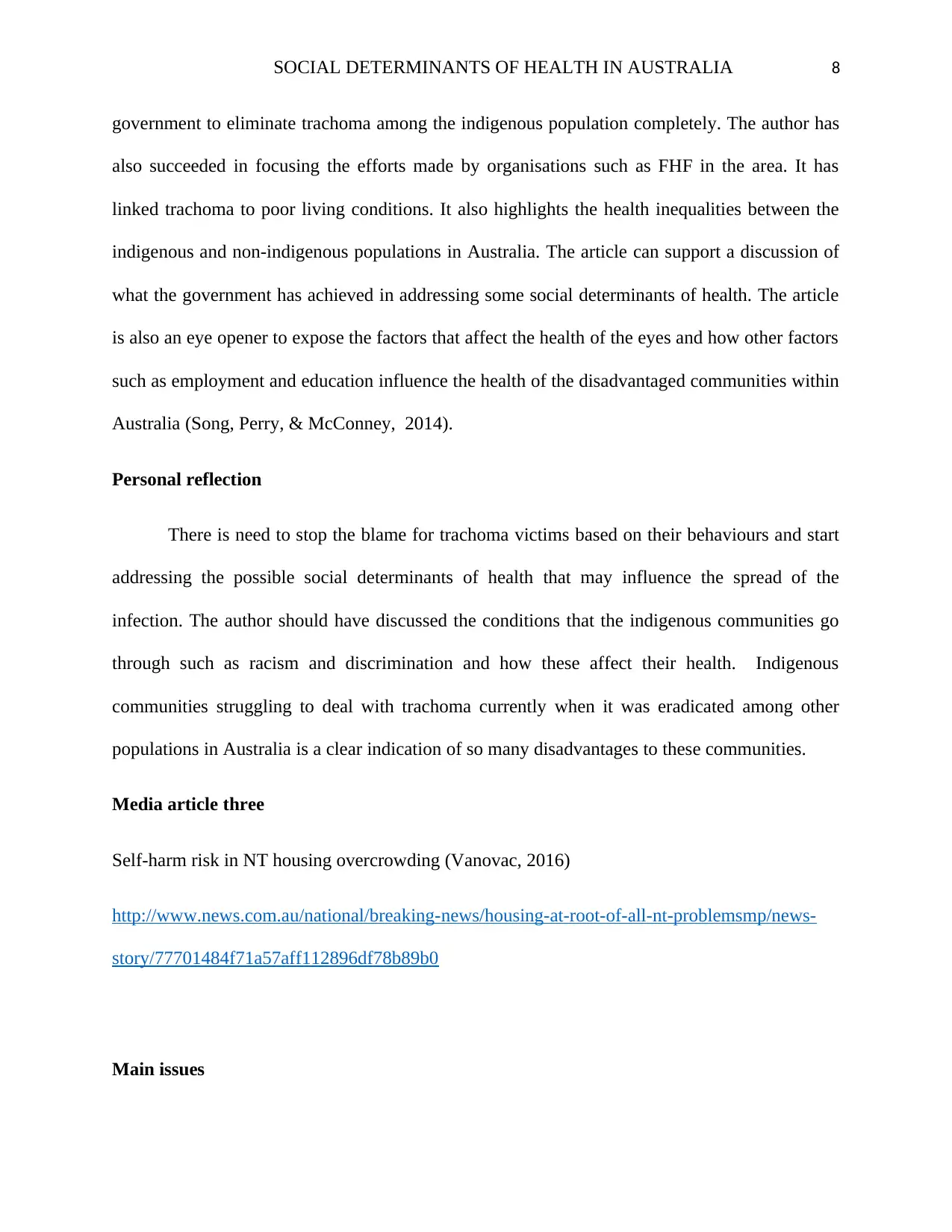
SOCIAL DETERMINANTS OF HEALTH IN AUSTRALIA 8
government to eliminate trachoma among the indigenous population completely. The author has
also succeeded in focusing the efforts made by organisations such as FHF in the area. It has
linked trachoma to poor living conditions. It also highlights the health inequalities between the
indigenous and non-indigenous populations in Australia. The article can support a discussion of
what the government has achieved in addressing some social determinants of health. The article
is also an eye opener to expose the factors that affect the health of the eyes and how other factors
such as employment and education influence the health of the disadvantaged communities within
Australia (Song, Perry, & McConney, 2014).
Personal reflection
There is need to stop the blame for trachoma victims based on their behaviours and start
addressing the possible social determinants of health that may influence the spread of the
infection. The author should have discussed the conditions that the indigenous communities go
through such as racism and discrimination and how these affect their health. Indigenous
communities struggling to deal with trachoma currently when it was eradicated among other
populations in Australia is a clear indication of so many disadvantages to these communities.
Media article three
Self-harm risk in NT housing overcrowding (Vanovac, 2016)
http://www.news.com.au/national/breaking-news/housing-at-root-of-all-nt-problemsmp/news-
story/77701484f71a57aff112896df78b89b0
Main issues
government to eliminate trachoma among the indigenous population completely. The author has
also succeeded in focusing the efforts made by organisations such as FHF in the area. It has
linked trachoma to poor living conditions. It also highlights the health inequalities between the
indigenous and non-indigenous populations in Australia. The article can support a discussion of
what the government has achieved in addressing some social determinants of health. The article
is also an eye opener to expose the factors that affect the health of the eyes and how other factors
such as employment and education influence the health of the disadvantaged communities within
Australia (Song, Perry, & McConney, 2014).
Personal reflection
There is need to stop the blame for trachoma victims based on their behaviours and start
addressing the possible social determinants of health that may influence the spread of the
infection. The author should have discussed the conditions that the indigenous communities go
through such as racism and discrimination and how these affect their health. Indigenous
communities struggling to deal with trachoma currently when it was eradicated among other
populations in Australia is a clear indication of so many disadvantages to these communities.
Media article three
Self-harm risk in NT housing overcrowding (Vanovac, 2016)
http://www.news.com.au/national/breaking-news/housing-at-root-of-all-nt-problemsmp/news-
story/77701484f71a57aff112896df78b89b0
Main issues
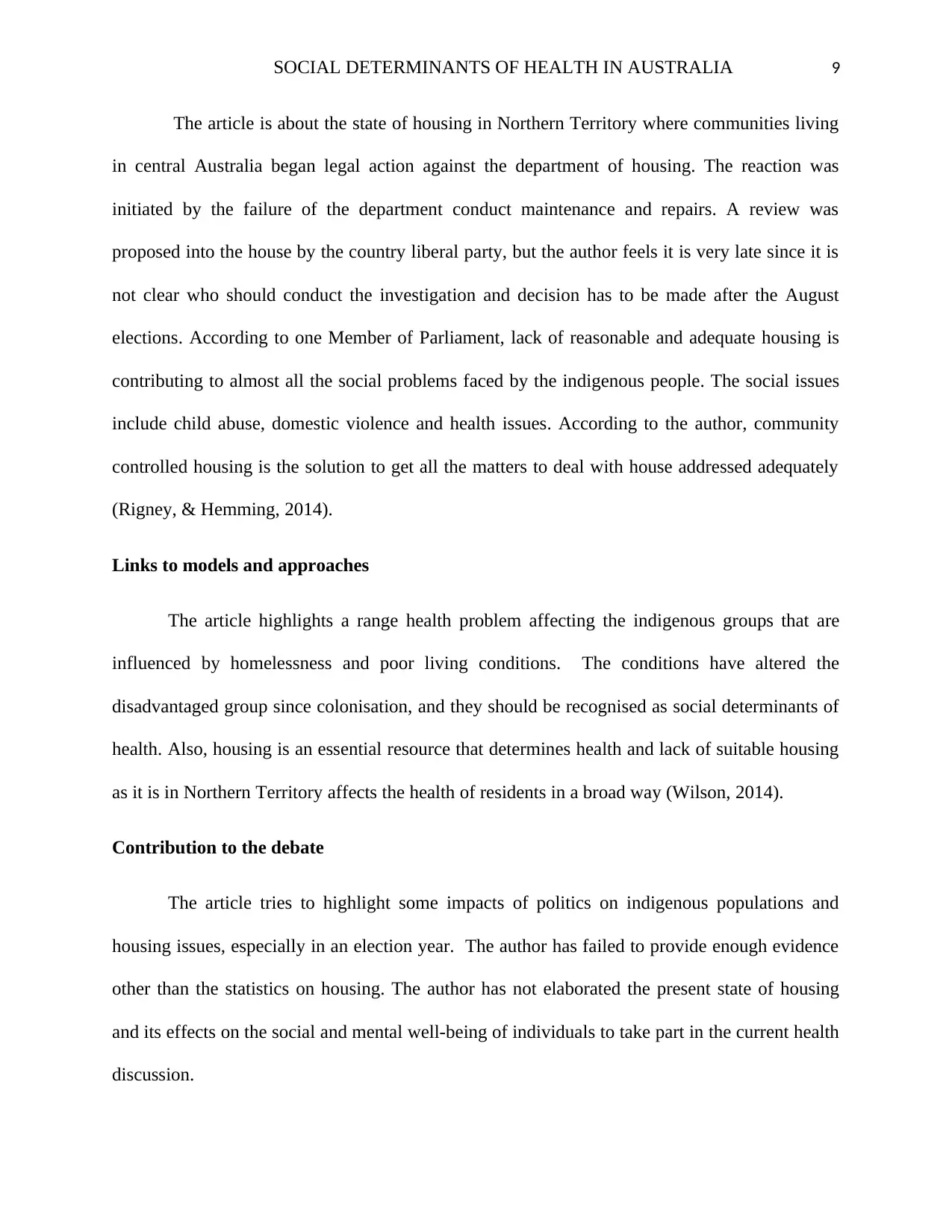
SOCIAL DETERMINANTS OF HEALTH IN AUSTRALIA 9
The article is about the state of housing in Northern Territory where communities living
in central Australia began legal action against the department of housing. The reaction was
initiated by the failure of the department conduct maintenance and repairs. A review was
proposed into the house by the country liberal party, but the author feels it is very late since it is
not clear who should conduct the investigation and decision has to be made after the August
elections. According to one Member of Parliament, lack of reasonable and adequate housing is
contributing to almost all the social problems faced by the indigenous people. The social issues
include child abuse, domestic violence and health issues. According to the author, community
controlled housing is the solution to get all the matters to deal with house addressed adequately
(Rigney, & Hemming, 2014).
Links to models and approaches
The article highlights a range health problem affecting the indigenous groups that are
influenced by homelessness and poor living conditions. The conditions have altered the
disadvantaged group since colonisation, and they should be recognised as social determinants of
health. Also, housing is an essential resource that determines health and lack of suitable housing
as it is in Northern Territory affects the health of residents in a broad way (Wilson, 2014).
Contribution to the debate
The article tries to highlight some impacts of politics on indigenous populations and
housing issues, especially in an election year. The author has failed to provide enough evidence
other than the statistics on housing. The author has not elaborated the present state of housing
and its effects on the social and mental well-being of individuals to take part in the current health
discussion.
The article is about the state of housing in Northern Territory where communities living
in central Australia began legal action against the department of housing. The reaction was
initiated by the failure of the department conduct maintenance and repairs. A review was
proposed into the house by the country liberal party, but the author feels it is very late since it is
not clear who should conduct the investigation and decision has to be made after the August
elections. According to one Member of Parliament, lack of reasonable and adequate housing is
contributing to almost all the social problems faced by the indigenous people. The social issues
include child abuse, domestic violence and health issues. According to the author, community
controlled housing is the solution to get all the matters to deal with house addressed adequately
(Rigney, & Hemming, 2014).
Links to models and approaches
The article highlights a range health problem affecting the indigenous groups that are
influenced by homelessness and poor living conditions. The conditions have altered the
disadvantaged group since colonisation, and they should be recognised as social determinants of
health. Also, housing is an essential resource that determines health and lack of suitable housing
as it is in Northern Territory affects the health of residents in a broad way (Wilson, 2014).
Contribution to the debate
The article tries to highlight some impacts of politics on indigenous populations and
housing issues, especially in an election year. The author has failed to provide enough evidence
other than the statistics on housing. The author has not elaborated the present state of housing
and its effects on the social and mental well-being of individuals to take part in the current health
discussion.
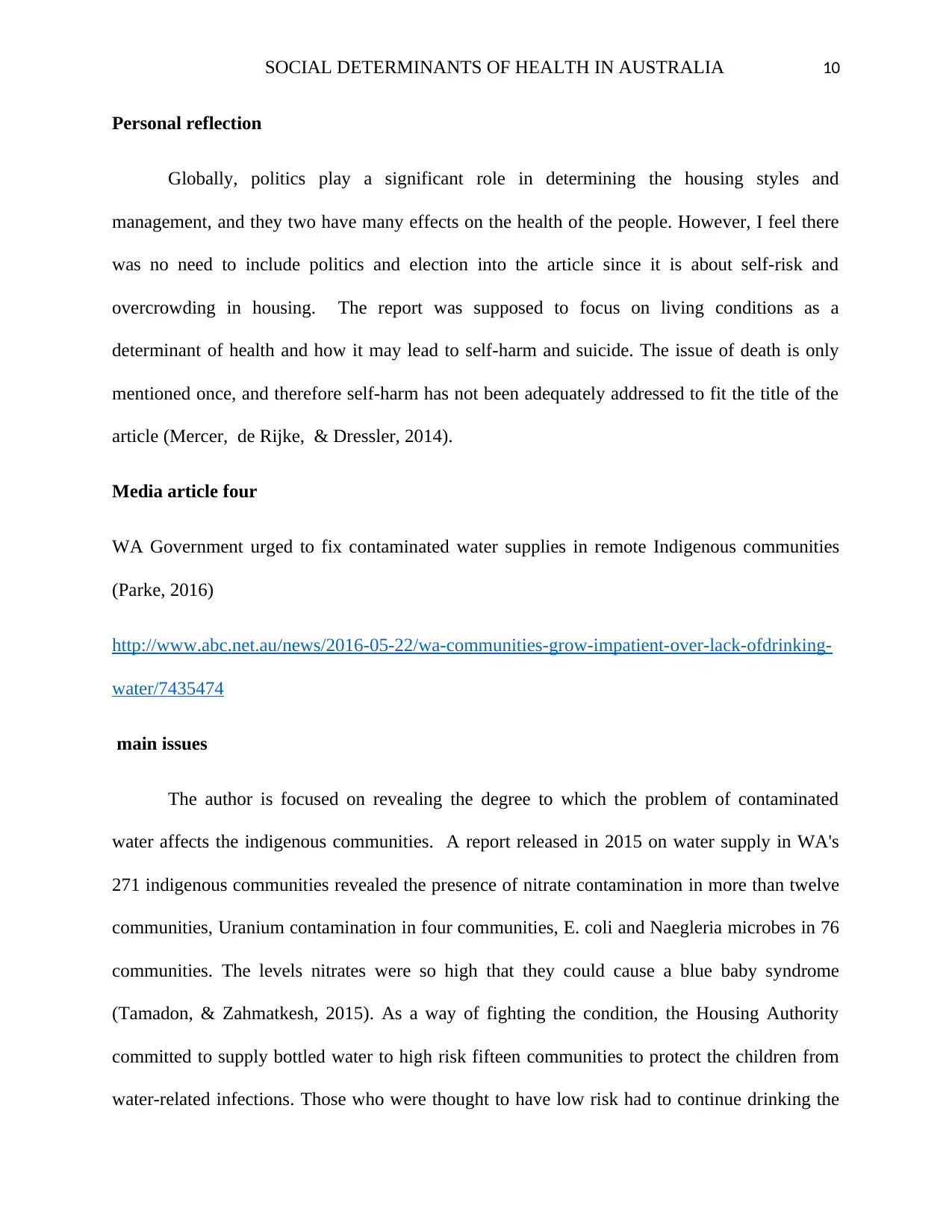
SOCIAL DETERMINANTS OF HEALTH IN AUSTRALIA 10
Personal reflection
Globally, politics play a significant role in determining the housing styles and
management, and they two have many effects on the health of the people. However, I feel there
was no need to include politics and election into the article since it is about self-risk and
overcrowding in housing. The report was supposed to focus on living conditions as a
determinant of health and how it may lead to self-harm and suicide. The issue of death is only
mentioned once, and therefore self-harm has not been adequately addressed to fit the title of the
article (Mercer, de Rijke, & Dressler, 2014).
Media article four
WA Government urged to fix contaminated water supplies in remote Indigenous communities
(Parke, 2016)
http://www.abc.net.au/news/2016-05-22/wa-communities-grow-impatient-over-lack-ofdrinking-
water/7435474
main issues
The author is focused on revealing the degree to which the problem of contaminated
water affects the indigenous communities. A report released in 2015 on water supply in WA's
271 indigenous communities revealed the presence of nitrate contamination in more than twelve
communities, Uranium contamination in four communities, E. coli and Naegleria microbes in 76
communities. The levels nitrates were so high that they could cause a blue baby syndrome
(Tamadon, & Zahmatkesh, 2015). As a way of fighting the condition, the Housing Authority
committed to supply bottled water to high risk fifteen communities to protect the children from
water-related infections. Those who were thought to have low risk had to continue drinking the
Personal reflection
Globally, politics play a significant role in determining the housing styles and
management, and they two have many effects on the health of the people. However, I feel there
was no need to include politics and election into the article since it is about self-risk and
overcrowding in housing. The report was supposed to focus on living conditions as a
determinant of health and how it may lead to self-harm and suicide. The issue of death is only
mentioned once, and therefore self-harm has not been adequately addressed to fit the title of the
article (Mercer, de Rijke, & Dressler, 2014).
Media article four
WA Government urged to fix contaminated water supplies in remote Indigenous communities
(Parke, 2016)
http://www.abc.net.au/news/2016-05-22/wa-communities-grow-impatient-over-lack-ofdrinking-
water/7435474
main issues
The author is focused on revealing the degree to which the problem of contaminated
water affects the indigenous communities. A report released in 2015 on water supply in WA's
271 indigenous communities revealed the presence of nitrate contamination in more than twelve
communities, Uranium contamination in four communities, E. coli and Naegleria microbes in 76
communities. The levels nitrates were so high that they could cause a blue baby syndrome
(Tamadon, & Zahmatkesh, 2015). As a way of fighting the condition, the Housing Authority
committed to supply bottled water to high risk fifteen communities to protect the children from
water-related infections. Those who were thought to have low risk had to continue drinking the
Secure Best Marks with AI Grader
Need help grading? Try our AI Grader for instant feedback on your assignments.
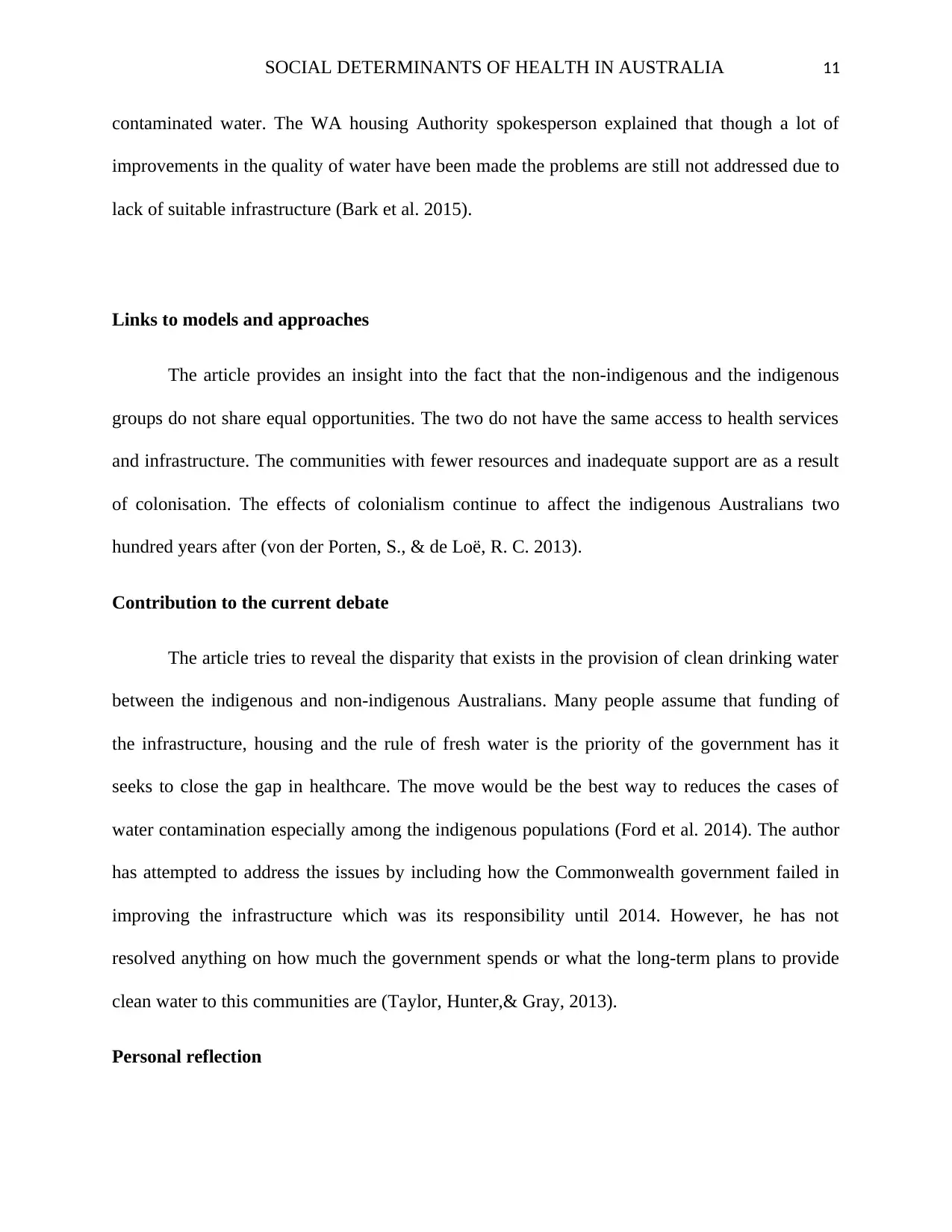
SOCIAL DETERMINANTS OF HEALTH IN AUSTRALIA 11
contaminated water. The WA housing Authority spokesperson explained that though a lot of
improvements in the quality of water have been made the problems are still not addressed due to
lack of suitable infrastructure (Bark et al. 2015).
Links to models and approaches
The article provides an insight into the fact that the non-indigenous and the indigenous
groups do not share equal opportunities. The two do not have the same access to health services
and infrastructure. The communities with fewer resources and inadequate support are as a result
of colonisation. The effects of colonialism continue to affect the indigenous Australians two
hundred years after (von der Porten, S., & de Loë, R. C. 2013).
Contribution to the current debate
The article tries to reveal the disparity that exists in the provision of clean drinking water
between the indigenous and non-indigenous Australians. Many people assume that funding of
the infrastructure, housing and the rule of fresh water is the priority of the government has it
seeks to close the gap in healthcare. The move would be the best way to reduces the cases of
water contamination especially among the indigenous populations (Ford et al. 2014). The author
has attempted to address the issues by including how the Commonwealth government failed in
improving the infrastructure which was its responsibility until 2014. However, he has not
resolved anything on how much the government spends or what the long-term plans to provide
clean water to this communities are (Taylor, Hunter,& Gray, 2013).
Personal reflection
contaminated water. The WA housing Authority spokesperson explained that though a lot of
improvements in the quality of water have been made the problems are still not addressed due to
lack of suitable infrastructure (Bark et al. 2015).
Links to models and approaches
The article provides an insight into the fact that the non-indigenous and the indigenous
groups do not share equal opportunities. The two do not have the same access to health services
and infrastructure. The communities with fewer resources and inadequate support are as a result
of colonisation. The effects of colonialism continue to affect the indigenous Australians two
hundred years after (von der Porten, S., & de Loë, R. C. 2013).
Contribution to the current debate
The article tries to reveal the disparity that exists in the provision of clean drinking water
between the indigenous and non-indigenous Australians. Many people assume that funding of
the infrastructure, housing and the rule of fresh water is the priority of the government has it
seeks to close the gap in healthcare. The move would be the best way to reduces the cases of
water contamination especially among the indigenous populations (Ford et al. 2014). The author
has attempted to address the issues by including how the Commonwealth government failed in
improving the infrastructure which was its responsibility until 2014. However, he has not
resolved anything on how much the government spends or what the long-term plans to provide
clean water to this communities are (Taylor, Hunter,& Gray, 2013).
Personal reflection
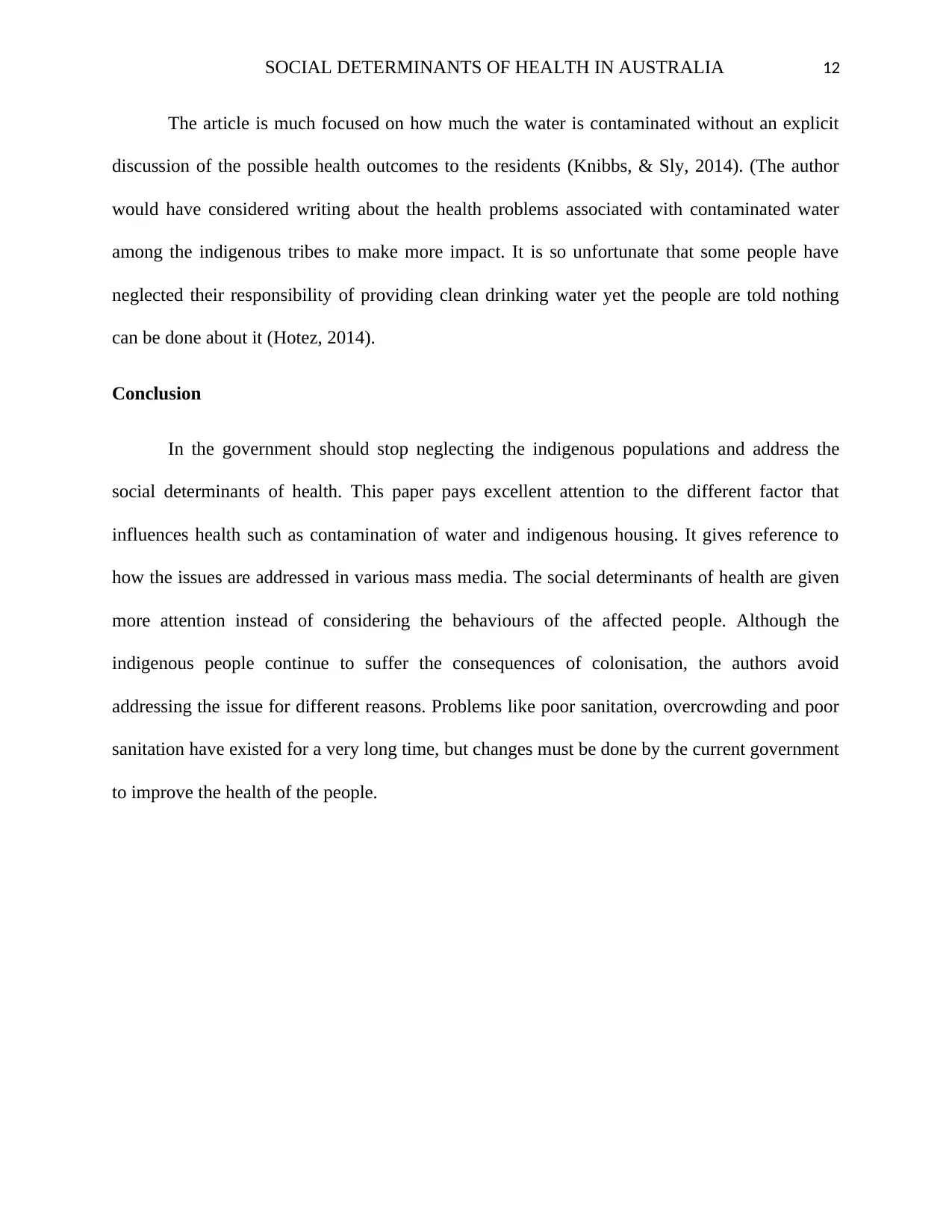
SOCIAL DETERMINANTS OF HEALTH IN AUSTRALIA 12
The article is much focused on how much the water is contaminated without an explicit
discussion of the possible health outcomes to the residents (Knibbs, & Sly, 2014). (The author
would have considered writing about the health problems associated with contaminated water
among the indigenous tribes to make more impact. It is so unfortunate that some people have
neglected their responsibility of providing clean drinking water yet the people are told nothing
can be done about it (Hotez, 2014).
Conclusion
In the government should stop neglecting the indigenous populations and address the
social determinants of health. This paper pays excellent attention to the different factor that
influences health such as contamination of water and indigenous housing. It gives reference to
how the issues are addressed in various mass media. The social determinants of health are given
more attention instead of considering the behaviours of the affected people. Although the
indigenous people continue to suffer the consequences of colonisation, the authors avoid
addressing the issue for different reasons. Problems like poor sanitation, overcrowding and poor
sanitation have existed for a very long time, but changes must be done by the current government
to improve the health of the people.
The article is much focused on how much the water is contaminated without an explicit
discussion of the possible health outcomes to the residents (Knibbs, & Sly, 2014). (The author
would have considered writing about the health problems associated with contaminated water
among the indigenous tribes to make more impact. It is so unfortunate that some people have
neglected their responsibility of providing clean drinking water yet the people are told nothing
can be done about it (Hotez, 2014).
Conclusion
In the government should stop neglecting the indigenous populations and address the
social determinants of health. This paper pays excellent attention to the different factor that
influences health such as contamination of water and indigenous housing. It gives reference to
how the issues are addressed in various mass media. The social determinants of health are given
more attention instead of considering the behaviours of the affected people. Although the
indigenous people continue to suffer the consequences of colonisation, the authors avoid
addressing the issue for different reasons. Problems like poor sanitation, overcrowding and poor
sanitation have existed for a very long time, but changes must be done by the current government
to improve the health of the people.
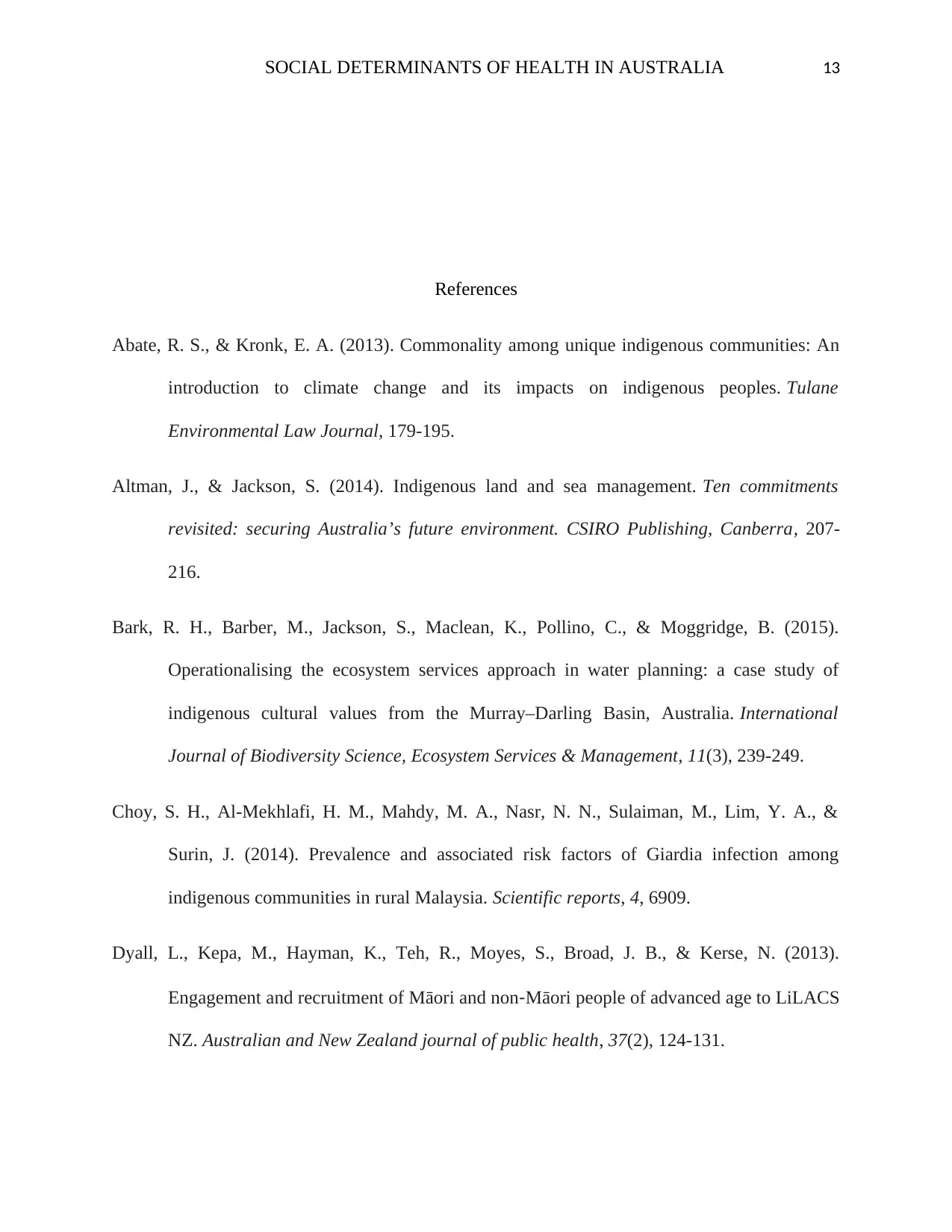
SOCIAL DETERMINANTS OF HEALTH IN AUSTRALIA 13
References
Abate, R. S., & Kronk, E. A. (2013). Commonality among unique indigenous communities: An
introduction to climate change and its impacts on indigenous peoples. Tulane
Environmental Law Journal, 179-195.
Altman, J., & Jackson, S. (2014). Indigenous land and sea management. Ten commitments
revisited: securing Australia’s future environment. CSIRO Publishing, Canberra, 207-
216.
Bark, R. H., Barber, M., Jackson, S., Maclean, K., Pollino, C., & Moggridge, B. (2015).
Operationalising the ecosystem services approach in water planning: a case study of
indigenous cultural values from the Murray–Darling Basin, Australia. International
Journal of Biodiversity Science, Ecosystem Services & Management, 11(3), 239-249.
Choy, S. H., Al-Mekhlafi, H. M., Mahdy, M. A., Nasr, N. N., Sulaiman, M., Lim, Y. A., &
Surin, J. (2014). Prevalence and associated risk factors of Giardia infection among
indigenous communities in rural Malaysia. Scientific reports, 4, 6909.
Dyall, L., Kepa, M., Hayman, K., Teh, R., Moyes, S., Broad, J. B., & Kerse, N. (2013).
Engagement and recruitment of Māori and non‐Māori people of advanced age to LiLACS
NZ. Australian and New Zealand journal of public health, 37(2), 124-131.
References
Abate, R. S., & Kronk, E. A. (2013). Commonality among unique indigenous communities: An
introduction to climate change and its impacts on indigenous peoples. Tulane
Environmental Law Journal, 179-195.
Altman, J., & Jackson, S. (2014). Indigenous land and sea management. Ten commitments
revisited: securing Australia’s future environment. CSIRO Publishing, Canberra, 207-
216.
Bark, R. H., Barber, M., Jackson, S., Maclean, K., Pollino, C., & Moggridge, B. (2015).
Operationalising the ecosystem services approach in water planning: a case study of
indigenous cultural values from the Murray–Darling Basin, Australia. International
Journal of Biodiversity Science, Ecosystem Services & Management, 11(3), 239-249.
Choy, S. H., Al-Mekhlafi, H. M., Mahdy, M. A., Nasr, N. N., Sulaiman, M., Lim, Y. A., &
Surin, J. (2014). Prevalence and associated risk factors of Giardia infection among
indigenous communities in rural Malaysia. Scientific reports, 4, 6909.
Dyall, L., Kepa, M., Hayman, K., Teh, R., Moyes, S., Broad, J. B., & Kerse, N. (2013).
Engagement and recruitment of Māori and non‐Māori people of advanced age to LiLACS
NZ. Australian and New Zealand journal of public health, 37(2), 124-131.
Paraphrase This Document
Need a fresh take? Get an instant paraphrase of this document with our AI Paraphraser
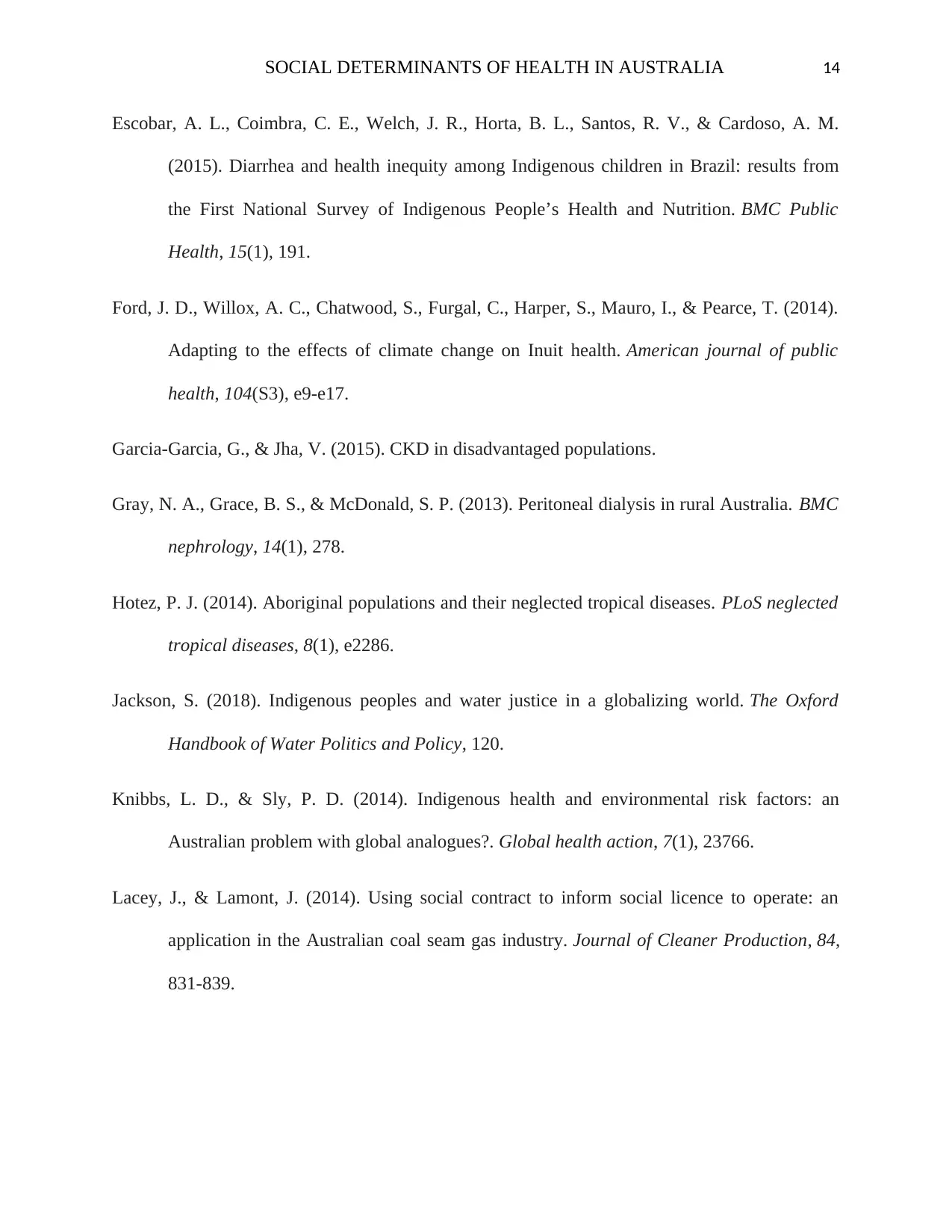
SOCIAL DETERMINANTS OF HEALTH IN AUSTRALIA 14
Escobar, A. L., Coimbra, C. E., Welch, J. R., Horta, B. L., Santos, R. V., & Cardoso, A. M.
(2015). Diarrhea and health inequity among Indigenous children in Brazil: results from
the First National Survey of Indigenous People’s Health and Nutrition. BMC Public
Health, 15(1), 191.
Ford, J. D., Willox, A. C., Chatwood, S., Furgal, C., Harper, S., Mauro, I., & Pearce, T. (2014).
Adapting to the effects of climate change on Inuit health. American journal of public
health, 104(S3), e9-e17.
Garcia-Garcia, G., & Jha, V. (2015). CKD in disadvantaged populations.
Gray, N. A., Grace, B. S., & McDonald, S. P. (2013). Peritoneal dialysis in rural Australia. BMC
nephrology, 14(1), 278.
Hotez, P. J. (2014). Aboriginal populations and their neglected tropical diseases. PLoS neglected
tropical diseases, 8(1), e2286.
Jackson, S. (2018). Indigenous peoples and water justice in a globalizing world. The Oxford
Handbook of Water Politics and Policy, 120.
Knibbs, L. D., & Sly, P. D. (2014). Indigenous health and environmental risk factors: an
Australian problem with global analogues?. Global health action, 7(1), 23766.
Lacey, J., & Lamont, J. (2014). Using social contract to inform social licence to operate: an
application in the Australian coal seam gas industry. Journal of Cleaner Production, 84,
831-839.
Escobar, A. L., Coimbra, C. E., Welch, J. R., Horta, B. L., Santos, R. V., & Cardoso, A. M.
(2015). Diarrhea and health inequity among Indigenous children in Brazil: results from
the First National Survey of Indigenous People’s Health and Nutrition. BMC Public
Health, 15(1), 191.
Ford, J. D., Willox, A. C., Chatwood, S., Furgal, C., Harper, S., Mauro, I., & Pearce, T. (2014).
Adapting to the effects of climate change on Inuit health. American journal of public
health, 104(S3), e9-e17.
Garcia-Garcia, G., & Jha, V. (2015). CKD in disadvantaged populations.
Gray, N. A., Grace, B. S., & McDonald, S. P. (2013). Peritoneal dialysis in rural Australia. BMC
nephrology, 14(1), 278.
Hotez, P. J. (2014). Aboriginal populations and their neglected tropical diseases. PLoS neglected
tropical diseases, 8(1), e2286.
Jackson, S. (2018). Indigenous peoples and water justice in a globalizing world. The Oxford
Handbook of Water Politics and Policy, 120.
Knibbs, L. D., & Sly, P. D. (2014). Indigenous health and environmental risk factors: an
Australian problem with global analogues?. Global health action, 7(1), 23766.
Lacey, J., & Lamont, J. (2014). Using social contract to inform social licence to operate: an
application in the Australian coal seam gas industry. Journal of Cleaner Production, 84,
831-839.
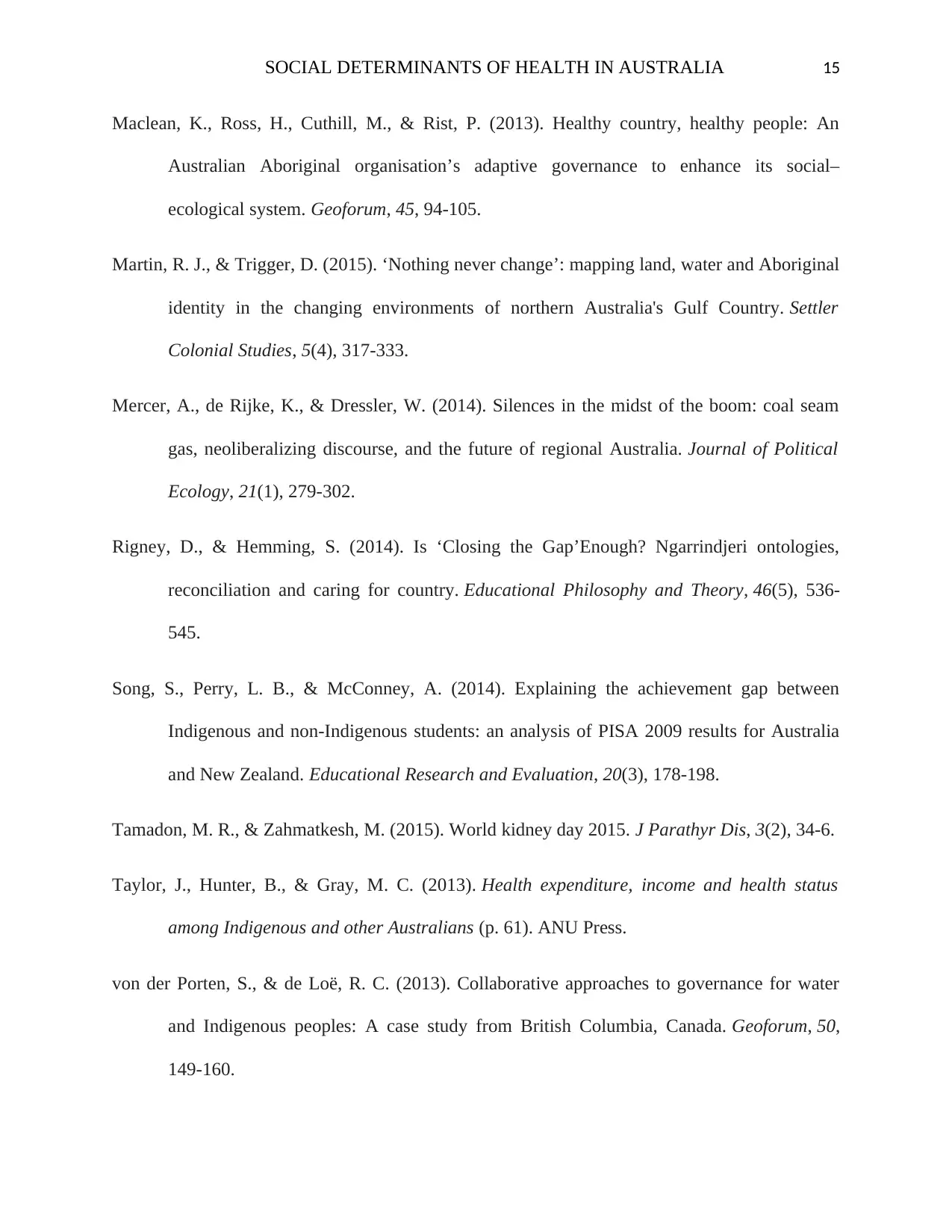
SOCIAL DETERMINANTS OF HEALTH IN AUSTRALIA 15
Maclean, K., Ross, H., Cuthill, M., & Rist, P. (2013). Healthy country, healthy people: An
Australian Aboriginal organisation’s adaptive governance to enhance its social–
ecological system. Geoforum, 45, 94-105.
Martin, R. J., & Trigger, D. (2015). ‘Nothing never change’: mapping land, water and Aboriginal
identity in the changing environments of northern Australia's Gulf Country. Settler
Colonial Studies, 5(4), 317-333.
Mercer, A., de Rijke, K., & Dressler, W. (2014). Silences in the midst of the boom: coal seam
gas, neoliberalizing discourse, and the future of regional Australia. Journal of Political
Ecology, 21(1), 279-302.
Rigney, D., & Hemming, S. (2014). Is ‘Closing the Gap’Enough? Ngarrindjeri ontologies,
reconciliation and caring for country. Educational Philosophy and Theory, 46(5), 536-
545.
Song, S., Perry, L. B., & McConney, A. (2014). Explaining the achievement gap between
Indigenous and non-Indigenous students: an analysis of PISA 2009 results for Australia
and New Zealand. Educational Research and Evaluation, 20(3), 178-198.
Tamadon, M. R., & Zahmatkesh, M. (2015). World kidney day 2015. J Parathyr Dis, 3(2), 34-6.
Taylor, J., Hunter, B., & Gray, M. C. (2013). Health expenditure, income and health status
among Indigenous and other Australians (p. 61). ANU Press.
von der Porten, S., & de Loë, R. C. (2013). Collaborative approaches to governance for water
and Indigenous peoples: A case study from British Columbia, Canada. Geoforum, 50,
149-160.
Maclean, K., Ross, H., Cuthill, M., & Rist, P. (2013). Healthy country, healthy people: An
Australian Aboriginal organisation’s adaptive governance to enhance its social–
ecological system. Geoforum, 45, 94-105.
Martin, R. J., & Trigger, D. (2015). ‘Nothing never change’: mapping land, water and Aboriginal
identity in the changing environments of northern Australia's Gulf Country. Settler
Colonial Studies, 5(4), 317-333.
Mercer, A., de Rijke, K., & Dressler, W. (2014). Silences in the midst of the boom: coal seam
gas, neoliberalizing discourse, and the future of regional Australia. Journal of Political
Ecology, 21(1), 279-302.
Rigney, D., & Hemming, S. (2014). Is ‘Closing the Gap’Enough? Ngarrindjeri ontologies,
reconciliation and caring for country. Educational Philosophy and Theory, 46(5), 536-
545.
Song, S., Perry, L. B., & McConney, A. (2014). Explaining the achievement gap between
Indigenous and non-Indigenous students: an analysis of PISA 2009 results for Australia
and New Zealand. Educational Research and Evaluation, 20(3), 178-198.
Tamadon, M. R., & Zahmatkesh, M. (2015). World kidney day 2015. J Parathyr Dis, 3(2), 34-6.
Taylor, J., Hunter, B., & Gray, M. C. (2013). Health expenditure, income and health status
among Indigenous and other Australians (p. 61). ANU Press.
von der Porten, S., & de Loë, R. C. (2013). Collaborative approaches to governance for water
and Indigenous peoples: A case study from British Columbia, Canada. Geoforum, 50,
149-160.
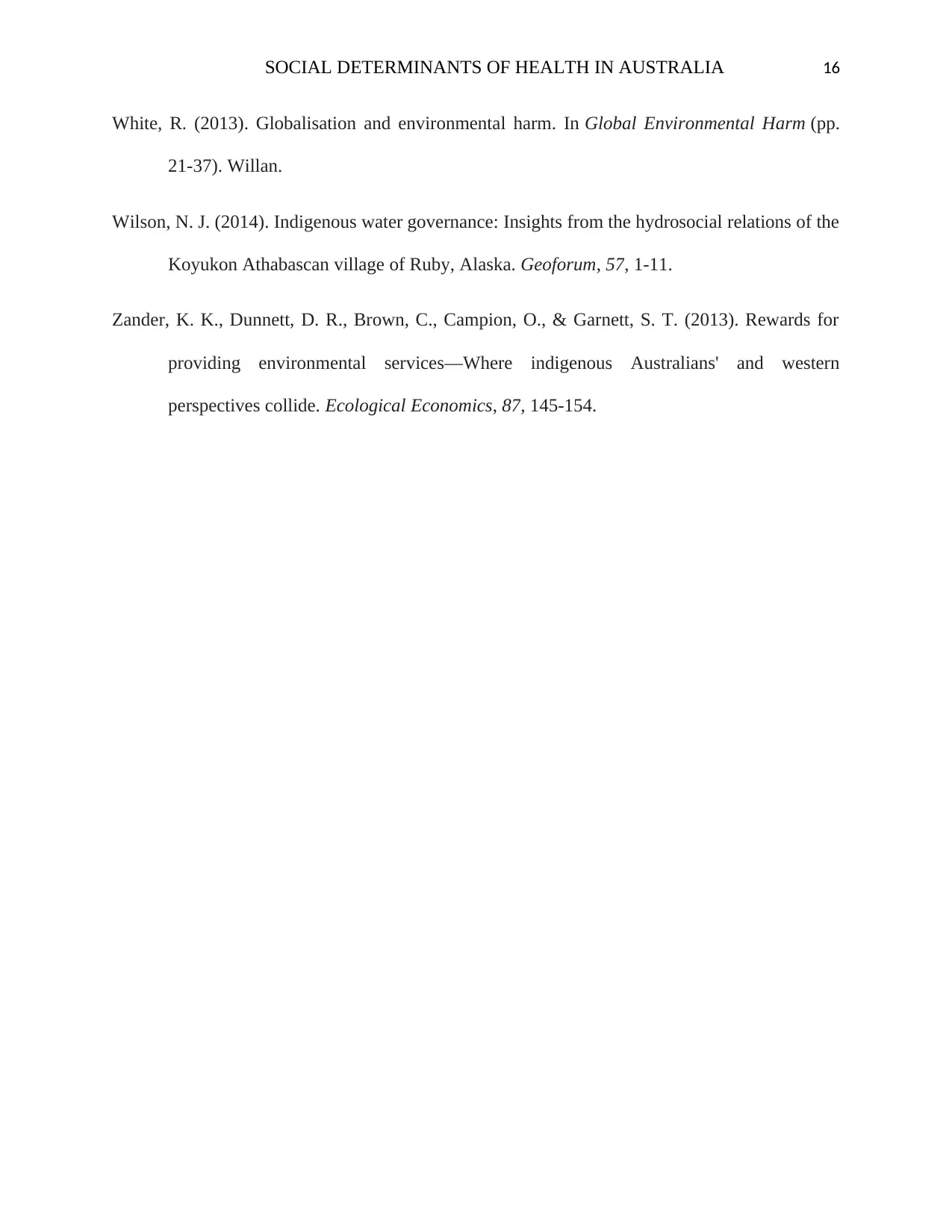
SOCIAL DETERMINANTS OF HEALTH IN AUSTRALIA 16
White, R. (2013). Globalisation and environmental harm. In Global Environmental Harm (pp.
21-37). Willan.
Wilson, N. J. (2014). Indigenous water governance: Insights from the hydrosocial relations of the
Koyukon Athabascan village of Ruby, Alaska. Geoforum, 57, 1-11.
Zander, K. K., Dunnett, D. R., Brown, C., Campion, O., & Garnett, S. T. (2013). Rewards for
providing environmental services—Where indigenous Australians' and western
perspectives collide. Ecological Economics, 87, 145-154.
White, R. (2013). Globalisation and environmental harm. In Global Environmental Harm (pp.
21-37). Willan.
Wilson, N. J. (2014). Indigenous water governance: Insights from the hydrosocial relations of the
Koyukon Athabascan village of Ruby, Alaska. Geoforum, 57, 1-11.
Zander, K. K., Dunnett, D. R., Brown, C., Campion, O., & Garnett, S. T. (2013). Rewards for
providing environmental services—Where indigenous Australians' and western
perspectives collide. Ecological Economics, 87, 145-154.
1 out of 16
Related Documents
Your All-in-One AI-Powered Toolkit for Academic Success.
+13062052269
info@desklib.com
Available 24*7 on WhatsApp / Email
![[object Object]](/_next/static/media/star-bottom.7253800d.svg)
Unlock your academic potential
© 2024 | Zucol Services PVT LTD | All rights reserved.





